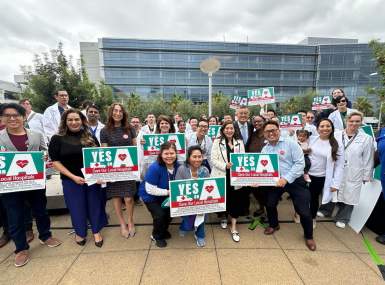Omicron surge tests counties
Upcoming Events
Related News

Key Takeaways
Counties continue to meet new challenges amidst a surge in cases of the COVID-19 Omicron variant nationwide. The latest wave in COVID-19 cases has counties facing test shortages, vaccine hesitancy, staffing problems, housing issues and skyrocketing infection rates. They’re meeting those challenges with mobile vaccine clinics, housing accommodations, school programs and finding ways to reduce transmission.
The country is experiencing the highest infection rate (a 216 percent increase in the two-week period between Dec. 27 and Jan. 10, according to the U.S. Department of Health and Human Services) and hospitalization rate (83 percent in the same time period) since the pandemic began.
DuPage County, Ill. is fighting back with proven techniques. “The challenges are the same,” said Karen Ayala, executive director of the DuPage County Health Department. “We know what we need to do to reduce or mitigate the risks related to Omicron...testing, staying home when people are sick, wearing masks in indoor settings and getting vaccinated are pillars of our ongoing COVID-19 response.”
“I think the challenge is that everything is needed in greater supply,” she noted. Through their efforts, the county has one of the highest vaccination rates among 5–11-year-olds, protecting some of the most vulnerable in the state.
The county is battling against vaccine hesitancy in their suburban communities by creating a mobile vaccine clinic called the CAREVAN, meeting residents at schools, community centers, grocery stores, churches, and more locations. Many residents have chosen to take the vaccine when it is made readily available to them, Ayala said, noting that the mobile clinic is a “key strategy for densely populated suburban communities.”
According to Chris Hoff, director of the county’s Community Health Resources, the key to victory lies with the community taking action to reduce transmission.
“In the short term, the focus is on ‘What can I do right now to help bring transmission down so my kids can stay in school, so I can safely go to work, so my community can get back to normal?’” he said.
With the surge heavily impacting staffing everywhere, Hoff said the “next few weeks will be a challenge in almost every sector.” He said these surges come in waves and that when cases are high, the community must take action to reduce the spread by reinstating prevention methods that work.
“I think people have a sense of futility,” Ayala said, “that ‘Regardless of what we do, it’s just going to happen anyway,’ and I don’t think that that is the case.”
In neighboring Lake County, Ill., the county became an early adopter of the Test-to-Stay program, which has led to an increase in students being able to safely stay in school after a potential exposure.
The program was tested over a three-month period, showing no increase in cases, saving in-school learning days. Emily Young, the marketing and communications manager for the Lake County Health Department, said instead of quarantining, any students who are exposed to COVID are instead tested on days 1, 3, 5 and 7 while remaining in school. They are also required to wear a mask and social distance.
The county is proud of the program and its success. Ayala encourages other counties to adopt Test-to-Stay; however, she warned it is not without its own difficulties. Test-to-Stay is a resource-intensive program, requiring space, training, and staff as well as tests that can be difficult to procure. The Centers for Disease Control and Prevention has released guidance on the program, describing Test-to-Stay as “another valuable tool in a layered prevention strategy.”
County health workers continue to battle fatigue as the pandemic enters its third year. “I think that my whole agency would echo the fact that so many of our folks continue to work so hard even though we’re going into multiple years of this [pandemic]…the fact that folks are showing up and still giving their all is really impressive and not to be underestimated,” said Young.
‘Navigators’ help get homeless vaccinated
In Minnesota, Hennepin County Administrator David Hough and Director of Housing Stability David Hewitt knew that the early response to the pandemic would dictate how well the county fared throughout the crisis. One of the strategies they employed was to rework their entire homeless assistance program. Overnight, shelters transitioned into 24/7 care, quarantine centers were established for the those showing symptoms, separate spaces were found for the medically vulnerable, hotels and motels were leased.
Plans took shape overnight to house, care for and reintroduce the homeless to a more stable situation. Hough said housing the critically in-need residents helps prevent them from relying on limited hospital services. To that end, the same day the county signed their disaster declaration was the same day they signed a lease for temporary housing. Hough said they also vaccinate individuals coming to the shelter, with more than 3,000 individuals vaccinated.
Paired with increased housing support, Hennepin County created the housing navigator program, a forward-thinking strategy to exit “crisis mode.” Navigators are housing-focused case managers able to support the homeless and get them the specific assistance they need, beginning with seniors and the medically at-risk.
“Navigators are critical in wrapping around and helping them get to self-sufficiency and stability,” said Hewitt.
He said having vision and clear goals throughout the disaster response helped the county focus and “deliver better outcomes for the folks that we’re serving.” Hewitt says homelessness should be “brief, rare, and nonrecurring,” a slogan his team has put into action.
‘One size doesn’t fit all’ in rural counties
In rural communities, despite the high infection rate of Omicron, residents have the space to distance and keep themselves safe. Commissioner John Espy of Carbon County, Wyo., said residents of the state often joke that they invented social distancing.
“We’re so spread out that it takes a lot for these things to really spread through the community” said Espy.
That does not mean the county is taking the situation lightly, they continue to encourage masking and vaccination to prevent the spread while keeping schools and other public facilities open and as safe as possible.
Espy said there are 15,000-16,000 people spread across 10 municipalities and 10,000 square miles allowing residents to remain distant, stay with their families and weather the surge. “I think each county needs to respond to it [COVID] with what works best for them. One size doesn’t fit all.”
County Administrator Jason Berry of Washington County said his rural area of Virginia is experiencing a surge akin to the early days of the pandemic. The region has experienced a surge from 19 percent around New Year’s Day to barely below 26 percent in a two-week span. Berry said the county has gone back to a mask mandate and social distancing.
The county has purchased enough rapid tests to keep staff in the office working and “keep the wheels of government rolling.”
Berry said he is hoping the surge will be as brief as it appears to be in other countries like in Africa when omicron first emerged. “We’re looking at the end of January, early February before things start getting better. That seems to be the trend we are on, but only time will tell.”

Attachments
Related News

CMS issues new guidance on Medicaid Community Engagement Requirements
On December 8, the Centers for Medicare & Medicaid Services (CMS) released a Medicaid and CHIP Services Informational Bulletin (CIB) directing states on how to implement the Medicaid community engagement requirements enacted under Section 71119 of the One Big Beautiful Bill Act legislation (Public Law 119-21), or H.R. 1.

California county sales tax measure backfills federal healthcare cuts
Santa Clara County, Calif. will raise an estimated $330 million each year from a sales tax to backfill lose Medicaid funding.
